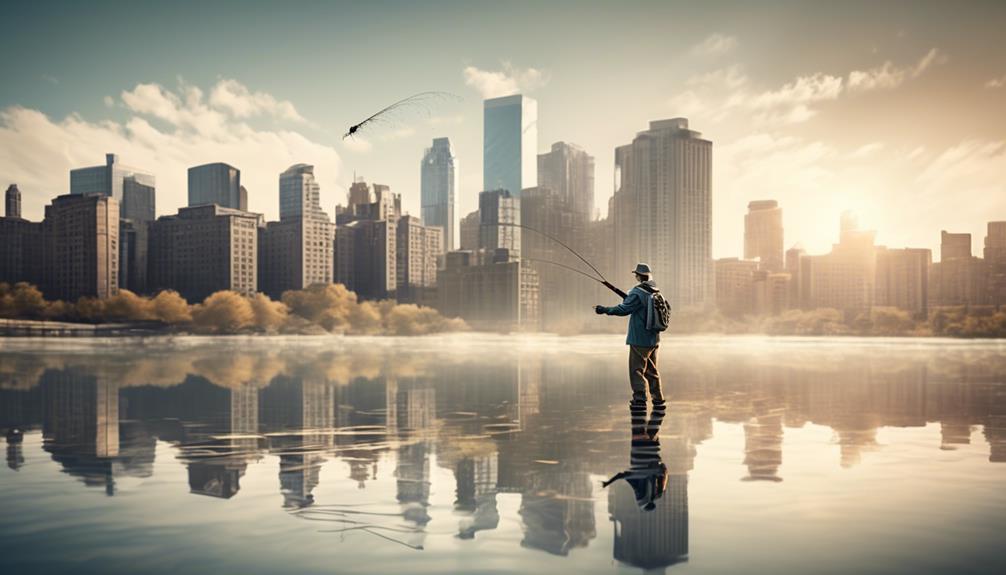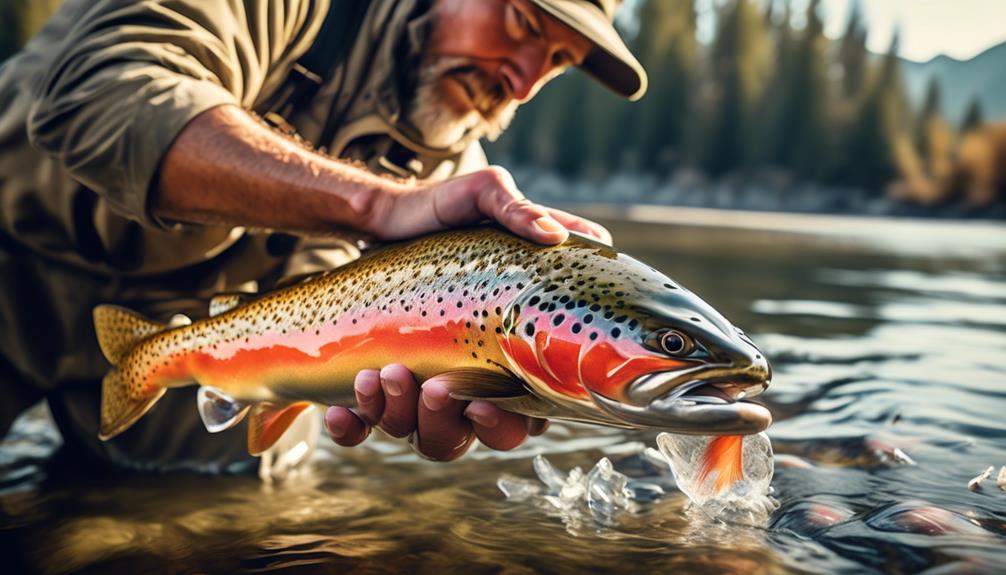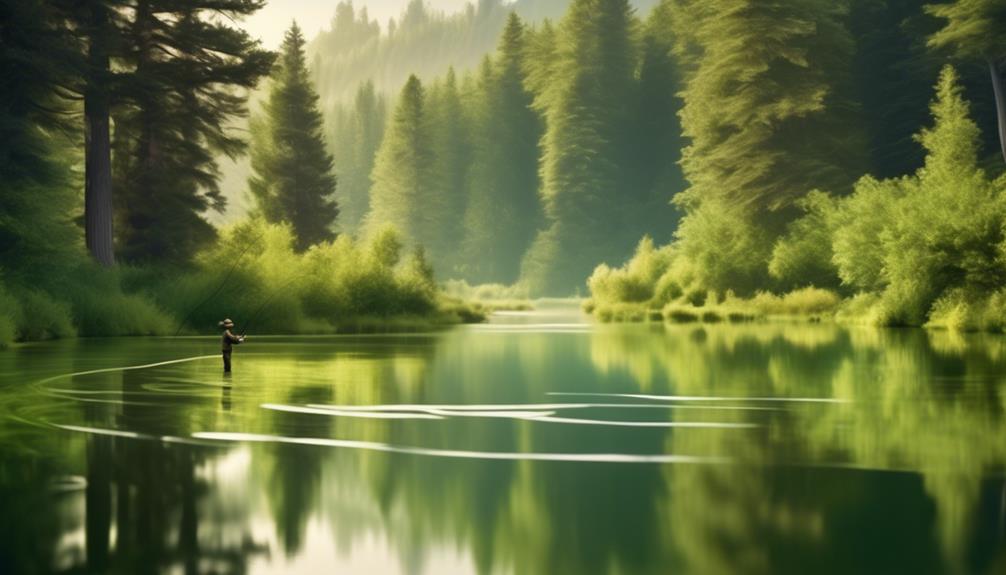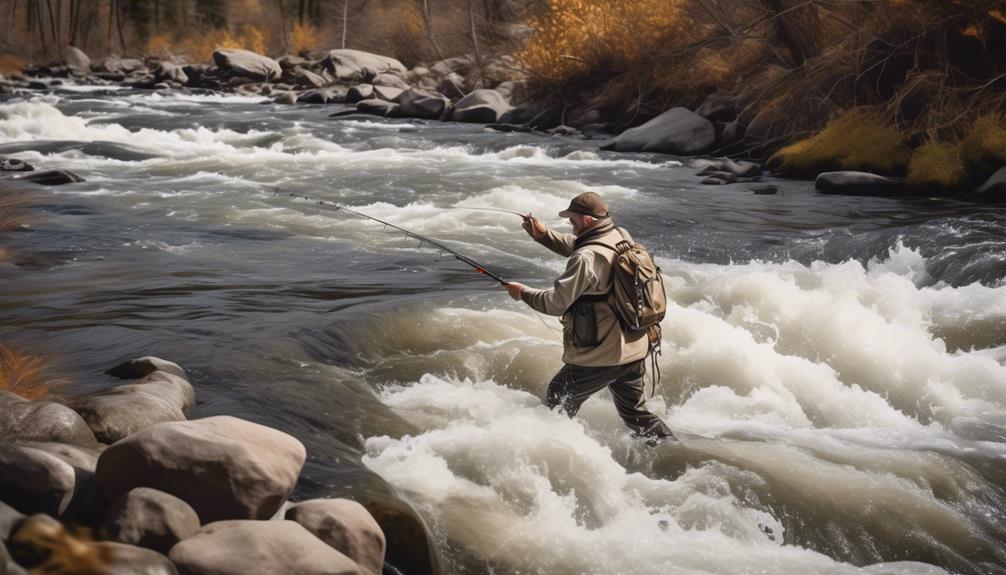Step into the world of urban pond carp fly fishing, where the tranquil surface belies the thrilling challenge that lies beneath.
As you stand by the water's edge, observing the gentle ripples and hidden movements, you're about to embark on a journey that will test your skills and patience.
But fear not, for within these pages, you will uncover the secrets to mastering the art of fly fishing for carp in urban ponds.
From understanding their behavior to selecting the perfect flies, and from mastering essential techniques to conserving these majestic creatures, this guide holds the key to unlocking a world of adventure right in the heart of the city.
Understanding Urban Pond Carp Behavior
How do urban pond carp behave in response to changing water temperatures and weather conditions?
Understanding the behavior of carp in an urban environment is crucial for successful fly fishing. In urban ponds, carp feeding patterns are influenced by various factors, including water temperature and weather conditions.
As the temperature changes, carp become more active, seeking out food sources and feeding more frequently. During warmer weather, carp are often found closer to the surface, actively feeding on insects and other aquatic organisms. However, in colder temperatures, carp tend to become more sluggish and may retreat to deeper waters, where they feed less frequently.
In urban environments, carp adapt to their surroundings by adjusting their feeding behavior. They're known to feed on a variety of natural and artificial food sources, including aquatic plants, algae, insects, and even human food waste. Carp have also been observed exhibiting cautious behavior in response to human activity around urban ponds. They may become more wary and selective in their feeding habits, making them more challenging to catch.
Understanding how carp behave in urban pond environments can help fly fishers anticipate their feeding patterns and adjust their fishing techniques accordingly. By observing the changing water temperatures and weather conditions, anglers can strategically plan their fishing trips to maximize their chances of success.
In the next section, we'll delve into the various fly fishing techniques that can be employed to effectively target urban pond carp.
Essential Fly Fishing Gear for Carp
When preparing for carp fly fishing in urban ponds, selecting the right gear is essential for a successful angling experience. Fly fishing for carp requires specific gear tailored to the unique challenges presented by these urban environments.
For fly tying, it's crucial to have a selection of flies that mimic the natural food sources of carp in urban ponds. Flies such as woolly buggers, crayfish patterns, and large nymphs are effective choices for enticing carp. Additionally, having a variety of sizes and colors can increase your chances of success.
Rod selection is another critical aspect of preparing for carp fly fishing. A 6 to 8-weight fly rod is generally recommended for targeting carp in urban ponds. This weight provides the necessary backbone to handle the weight and power of carp while still offering the finesse required for accurate casting and presentation.
When choosing a rod, consider the size of the urban pond and the potential obstacles, such as overhanging trees or structures, that may affect your casting ability. A rod with enough strength to control the fish while being sensitive to subtle takes is ideal for urban pond carp fly fishing.
Selecting the Best Flies for Urban Pond Carp
To increase your chances of success in urban pond carp fly fishing, selecting the best flies tailored to mimic the natural food sources of carp is essential. Understanding carp behavior and their feeding habits is crucial for fly selection. Here are some tips to help you choose the best flies for urban pond carp:
- Natural Imitations: Look for flies that closely resemble the natural food sources of carp such as aquatic insects, crustaceans, and small fish. Flies like damselfly nymphs, crayfish patterns, and small minnow imitations can be highly effective.
- Size Matters: Carp can be picky eaters, so it's important to match the size of your fly to the natural food available in the pond. Pay attention to the size of insects and other organisms around the pond to select flies that closely match the size.
- Movement and Presentation: Choose flies that exhibit natural movement in the water. Flies with subtle, lifelike movements can entice carp to strike. Additionally, consider the presentation of the fly, as carp can be wary and easily spooked.
- Color Consideration: Carp have good color vision, so selecting flies with natural colors that blend well with the pond environment is important. Earthy tones, olive, brown, and black are often effective choices.
- Sinking Flies: Carp tend to feed along the bottom of ponds, so using sinking flies that can be presented at different depths can be advantageous. Consider using weighted nymphs or streamers that can be presented near the bottom where carp are actively feeding.
Locating Hotspots in Urban Ponds
As you search for urban pond carp hotspots, consider the areas where natural food sources are abundant and likely to attract feeding carp. Understanding carp feeding behavior and the urban pond ecology is key to locating these hotspots.
Look for shallow areas with aquatic vegetation, such as lily pads, reeds, and submerged plants, as these provide shelter for insects and crustaceans, which are primary food sources for carp. Additionally, pay attention to any inflowing streams or drains, as these can bring in nutrients and small organisms, attracting carp looking for a meal.
Another hotspot to look out for is any structure in the pond, such as overhanging trees, submerged logs, or rocky areas. These structures provide hiding spots for prey and offer carp a place to forage. In urban ponds, bridges, culverts, and other human-made structures can also create hotspots, as they often attract insects and other small organisms, drawing in carp for feeding.
Furthermore, observe the surface of the water for any signs of carp feeding activity, such as bubbling, swirling, or the occasional glimpse of their dorsal fins. These indications can guide you to potential hotspots where carp are actively feeding.
Mastering Carp Fly Fishing Techniques
Explore the nuances of carp fly fishing techniques, incorporating strategic casting and presentation methods to enhance your chances of a successful catch. When it comes to mastering carp fly fishing, paying attention to casting accuracy and retrieval techniques is crucial.
Here are five essential tips to help you improve your carp fly fishing game:
- Perfect Your Casting Accuracy: Carp are known for their wariness, so it's vital to develop your casting accuracy. Practice casting at different distances and angles to hone your skills. Aim to place your fly precisely where the carp are feeding, taking into account wind direction and potential obstacles.
- Master the Art of Presentation: Once your fly lands on the water, it's essential to present it in a natural and enticing manner. This involves understanding the behavior of feeding carp and adjusting the retrieval speed and fly movement accordingly.
- Utilize Stealthy Retrieval Techniques: Carp are sensitive to disturbances, so employing stealthy retrieval techniques is key. Slow, deliberate retrieves, and subtle rod movements can make your fly look more natural, increasing the likelihood of a strike.
- Observe and Adapt: Pay close attention to how the carp are responding to your presentation. Be ready to adapt your techniques based on their behavior, such as slowing down or speeding up your retrieval to entice hesitant fish.
- Practice Patience and Persistence: Carp fly fishing requires patience and persistence. Stay focused, observe the water, and be prepared to put in the time needed to master these techniques.
Strategies for Catching Trophy Carp
Enhance your chances of landing a trophy carp by implementing advanced baiting and hook-setting strategies. Understanding carp feeding habits is crucial to catching trophy fish.
Carp are omnivorous and often feed on the bottom, so using effective bottom baiting techniques is essential. Consider using a combination of natural baits such as maize, boilies, and pellets to attract trophy carp. By presenting a diverse range of baits, you can increase your chances of enticing larger carp to your hook.
Another important aspect of catching trophy carp is understanding their habitat. Trophy carp tend to inhabit areas with ample natural food sources, such as weed beds, lily pads, and deeper waters with access to shallow feeding areas. Targeting these specific areas can significantly increase your chances of hooking a trophy carp. When fishing in urban pond environments, look for areas with sufficient vegetation and underwater structures where carp are likely to seek shelter and food.
Once you have identified the ideal carp habitat, it's essential to employ effective hook-setting strategies. Since trophy carp are known for their cautious feeding behavior, using a hair rig setup with a well-disguised hook can improve your chances of successfully hooking a big carp. Ensure that your bait is securely attached to the rig, allowing the carp to feed without detecting the presence of the hook.
Urban Pond Carp Conservation and Ethics

For those who enjoy urban pond carp fly fishing, it's important to prioritize conservation and ethical practices to ensure the sustainability of this recreational activity. As urban pond carp populations face increasing pressures, it's crucial for anglers to take responsibility in preserving these fish for future generations. Here are some key practices to uphold when engaging in urban pond carp fly fishing:
- Respect Carp Population: Be mindful of the carp population in urban ponds. Avoid overharvesting and adhere to local regulations regarding catch limits to maintain a healthy and balanced carp population.
- Practice Catch and Release: Implement catch and release techniques to minimize the impact on carp populations. Handle the fish with care, use barbless hooks, and release the carp promptly to ensure their well-being.
- Use Appropriate Tackle: Equip yourself with the right gear to minimize harm to the carp. Use appropriate hook sizes and tackle to reduce injury and stress to the fish during the catch and release process.
- Minimize Environmental Impact: Dispose of fishing line, hooks, and other waste responsibly to prevent harm to the environment and wildlife. Leave the fishing area cleaner than you found it.
- Educate Others: Share your knowledge and passion for urban pond carp fly fishing with others. Educate fellow anglers about the importance of conservation and ethical practices to collectively safeguard the carp population.
Tips for Successful Urban Pond Carp Fly Fishing
When aiming for successful urban pond carp fly fishing, prioritize conservation and ethical practices to ensure the sustainability of this recreational activity, ensuring that the carp population remains healthy for future generations.
To enhance your chances of a successful catch, understanding fly presentation and carp feeding habits is crucial. Carp are often found in urban ponds where they feed on the bottom, sifting through mud and debris for food. When presenting your fly, it's essential to mimic the natural food sources carp are accustomed to. Use flies that resemble aquatic insects, crustaceans, or small fish, as these are staple items in a carp's diet.
As carp are primarily bottom feeders, your presentation should be close to the pond's floor. Utilize sinking lines or weighted flies to ensure your presentation is at the right depth. Additionally, carp can be selective feeders, so observe their behavior to understand their preferences. Experiment with different fly patterns, sizes, and colors to determine what entices the carp in your specific pond.
Patience is key when targeting carp, as they can be cautious and may take time to inspect before deciding to feed. By understanding their feeding habits and presenting your fly effectively, you can significantly increase your chances of a successful urban pond carp fly fishing experience.
Frequently Asked Questions
How Can I Ensure That I Am Fishing Responsibly and Ethically in Urban Ponds?
To ensure responsible angling in urban ponds, practice catch and release, use barbless hooks, and avoid disturbing wildlife. Conservation techniques like picking up trash and properly disposing of fishing line also help protect the environment.
What Are Some Common Mistakes That Beginner Urban Pond Carp Fly Fishers Make, and How Can I Avoid Them?
When starting urban pond carp fly fishing, avoid common mistakes like improper gear and misunderstanding carp behavior. Focus on proper fly presentation to increase your chances of success. Stay patient and observant.
Are There Any Specific Regulations or Restrictions I Need to Be Aware of When Fly Fishing for Carp in Urban Ponds?
Before heading out to urban ponds for carp fly fishing, be sure to check local regulations. Many areas have specific rules in place to protect the conservation efforts, such as permits and catch-and-release practices.
What Are Some Effective Ways to Attract Carp to My Fly and Increase My Chances of a Successful Catch?
To attract carp to your fly and improve your chances of catching them, observe their behavior and adjust your fly presentation techniques accordingly. Experiment with different patterns and movements to entice the carp effectively.
How Can I Best Handle and Release Carp to Ensure Their Survival and the Health of the Urban Pond Ecosystem?
When handling carp, gently support their body, avoid removing protective slime, and quickly release them back into the water. Proper fish handling ensures their survival and maintains the health of the urban pond ecosystem.
Conclusion
Now that you have the ultimate guide to urban pond carp fly fishing, you're ready to hit the waters and reel in some trophy carp.
Remember to respect the environment and practice ethical fishing techniques.
With the right gear, flies, and knowledge of carp behavior, you'll have a successful and rewarding experience.
So grab your gear, head to your favorite urban pond, and get ready to catch some impressive carp!



